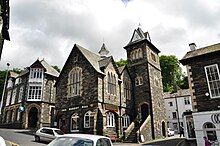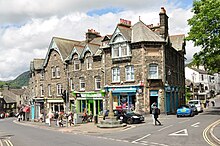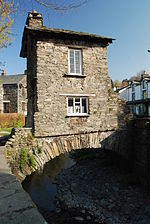inscribed and dated "Fairfield Range from Gale How , Ambleside, Cumbria 1875" and signed with initials "LWT"
Tom and Laura Taylor and thence by descent
Fairfield is one of the most impressive Lake District fell walks, and for lovers of high level circuits, this is a sure fire ‘classic’. The Fairfield Horseshoe is a stunning sight and towers high above Ambleside, leaving the shoppers and cafe goers looking up in awe. From Fairfield’s summit you can see spectacular views in every direction. The Fairfield Horseshoe is host to eight summits including Low Pike, High Pike, Dove Crag, Hart Crag, Great Rigg, Heron Pike and Nab Scar.
The walk along the ridge is long but thoroughly satisfying; leaving you invigorated and wanting more. It is a challenging and rewarding day out, offering walkers an array of summits, excellent scenery, tarns, streams and roaming fells. The Fairfield guided walk is the ultimate horseshoe and the next step into the world of Lake District Mountains.
Fairfield is a fell in the English Lake District. It is the highest of a group of hills in the Eastern Fells, standing to the south of the Helvellyn range.
There is a marked contrast between the character of the northern and southern flanks of Fairfield. Alfred Wainwright in his influential Pictorial Guide to the Lakeland Fells wrote that "From the south it appears as a great horseshoe of grassy slopes below a consistently high skyline...but lacking those dramatic qualities that appeal most to the lover of hills. But on the north side the Fairfield range is magnificent: here are dark precipices, long fans of scree...desolate combes and deep valleys."
Fairfield has connecting ridges to several other fells and in plan view can be likened to a bow-tie. The top has an east–west axis with ridges running out north and south from each end.
The two southern arms make up the popular walk, the Fairfield horseshoe, which starts in Ambleside and makes a circuit of the valley of Rydale to the south. On the western side, descending from Fairfield are Great Rigg, Heron Pike and Nab Scar while the eastern ridge bears the tops of Hart Crag, Dove Crag, High Pike and Low Pike.
The north-western ridge of Fairfield crosses Deepdale Hause to St Sunday Crag whilst that to the north east is a short rocky spur into Deepdale, dropping over Greenhow End. A fifth line of high ground, less a ridge than a salient in the breast of the fell, runs due west to Seat Sandal across Grisedale Hause.
The northern and eastern faces all loom above the desolate upper Deepdale, which is divided by Greenhow End. This short rocky spur has Hutaple Crag on the west and Scrubby Crag on the east. The corries of Cawk Cove and Link Cove lie on either side, each with a steep headwall formed by the flanks of Fairfield.
North-west of Fairfield is Grisedale Tarn at around 1,770 ft (540 m). This sizeable tarn has a depth of over 100 ft (30 m) and holds brown trout, perch and eels. It is also the legendary resting place of the crown of Dunmail, following his—perhaps equally legendary—defeat in battle at Dunmail Raise.The outflow is to Ullswater, 3 miles (4.8 km) to the north-east along the strath of Grisedale. The south western flank of Fairfield looks down on Tongue Gill, a feeder of Raise Beck and Grasmere.
The volcaniclastic sandstone and lapilli-tuff of the Deepdale Formation overlie the dacitic lapilli-tuff of the Helvellyn Formation.

The summit is a rough stony plateau with the high point at the western end above the brink of Cawk Cove. The top is very flat and there are many cairns, including a pair of large windbreaks near the high point.
Guidebook writers warn that it is easy to get lost in mist and that the cautious walker should beware of the presence of precipices to the north and west. The vista is fine, with all of the major fell groups well seen and views down into the abyss of Deepdale only yards away. Other fells visible at close hand include Helvellyn (with its spectacular arête Striding Edge), Nethermost Pike, Saint Sunday Crag and Cofa Pike (a subsidiary summit of Fairfield). The view south towards Ambleside and Rydal over Rydal Head is also extensive, with Windermere and Coniston Water in view.

Fairfield is most commonly climbed as the high point of the Fairfield horseshoe, a walk which has no agreed direction of travel. Coming from Great Rigg, the long grassy ridge heads directly for the summit, whilst the walker arriving from Hart Crag climbs up from Link Hause with a fine view of Scrubby Crag to the right, before the stony traverse of Fairfield summit.
Perhaps the finest indirect ascent is from Patterdale via Birks and St Sunday Crag, following the fine narrow ridge down to Deepdale Hause before ascending rough ground to Cofa Pike. This subsidiary top of Fairfield has a fine peaked profile, quite outdoing its parent until the wide tabletop comes into view behind. A further rock tor is surmounted before the summit windbreaks are reached. From St Sunday Crag onwards the northern crags of Fairfield are seen in their full and wild glory.
Fairfield can be climbed via Grisedale Hause, either up Tongue Gill from Grasmere, from Dunmail Raise or from Patterdale. The path up from the Hause is a rough zigzag up worsening scree. Grisedale Hause can also be reached as a ridge walk from Seat Sandal, or by cutting across the outlet of Grisedale Tarn from Dollywaggon Pike and the Helvellyns. In this way Fairfield forms part of the Threlkeld–Kirkstone Walk, which continues over Fairfield summit to Dove Crag and Red Screes.
A more challenging route climbs out of Deepdale, veering into the lower part of Link Cove before surmounting Greenhow End and The Step. Deepdale Hause can also be gained from this side, but climbs direct out of Link Cove or Cowk Cove are not practicable for walkers.
Ambleside is a town and former civil parish (now in the parish of Lakes) in the Westmorland and Furness district of Cumbria, England. Within the boundaries of the historic county of Westmorland and located in the Lake District National Park, the town sits at the head of Windermere, England's largest natural lake. In 2020 it had an estimated population of 2596.
Ambleside is within the unitary authority Westmorland and Furness, and is also part of the Lakes civil parish. Ambleside was formerly a township, in 1866 Ambleside became a civil parish in its own right until it was abolished on 1 April 1974 to form Lakes. In 1961 the parish had a population of 2562.
From 1894 to 1935, Ambleside formed its own urban district.
"Steamers" are the throwback name for the ferries (diesel-propelled) which run most days to Bowness-on-Windermere and Lakeside offering fine views of the lake and the mountains – see Waterhead locality below.
Ambleside is a base for hiking, mountaineering and mountain biking. It has several hotels, guest houses, restaurants and shops. Specialist shops sell equipment, guides and give recommendations to walkers, backpackers and climbers. Ambleside is a popular starting point for the Fairfield horseshoe, a hillwalking ridge hike.
A concentration of ten pubs or bars within a quarter-mile radius reflects how the local hospitality market serves residents, tourists, visitors and the student population associated with the University of Cumbria.
The town's name is derived from the Old Norse "Á-mel-sǽtr" which literally translates as "river – sandbank – summer pasture".

To the south of Ambleside is the Roman fort of Galava, dating from AD 79.
In 1650 the town was granted a charter to hold a market. In the reign of James II, another charter was granted for the town to collect tolls. The town's Market Place became the commercial centre for agriculture and the wool trade. The old packhorse trail between Ambleside and Grasmere was the main route between the two towns before the new turnpike road was completed in 1770. Smithy Brow at the end of the trail was where pack ponies were re-shod after their journey. With the coming of the turnpikes, the packhorse trains were superseded by horse-drawn stagecoaches, which regularly travelled between Keswick and Kendal via Ambleside.
The Samling Hotel was built in the 1780s, then called the "Dove Nest".

Ambleside & District Golf Club founded in 1903 ended in the late 1950s; Windermere Golf Club is a few miles along the lake's east side.
The Armitt Library and Museum opened in 1912 in memory of Sophia and Mary Louisa Armitt is notable as a resource for history. Its main resident collection overviews Lake District artists and writers with display panels, photographs and copies of their key works, and some originals of minor works.

Bridge House was built over Stock Ghyll more than 300 years ago, probably as a summer house and apple store for Ambleside Hall. It was purchased by local people in 1926 and given to the National Trust. Listed Grade I, the building is now used as an information centre for the National Trust, and is part of the Trust's Windermere and Troutbeck property.

The building was depicted by the Victorian landscapist Lewis Pinhorn Wood (1848–1918) in his late 19th century work The Cobbler's Shop on the Bridge.
Main article: St Mary's Church, Ambleside

A shared Church of England and Methodist church. Before the 17th century the dead of Ambleside were buried at St Martin's Church, Bowness-on-Windermere, Ambleside then gained the right to its own registers and had a chapel dedicated to St Anne. This was too small to accommodate the enlarged Anglican congregations as tourism boomed from the Kendal and Windermere Railway opened in 1847. St Mary's Church was built in the 1850s to a design by George Gilbert Scott in the Gothic Revival style. Notable features include:
- the stone spire, an unusual feature in Westmorland churches,
- the mural depicting rushbearing (a ceremony which is held on the first Saturday in July). The mural was created during World War II when the Royal College of Art was based in Ambleside.
Early 20th century Vicar, Henry Adamson Thompson, is depicted on the right of the mural. His body and that of his only son, Henry Lionel Francess Thompson – killed in World War II – share the same part of the churchyard.
Other burials include Annie, Sophia and Mary Louisa Armitt.
The town's many decades-old Catholic Church in a traditional design is a consolidation of two churches; until 2013 nearby Grasmere held services, whose reverend, Kevan Dorgan of Windermere was translated to the consolidated parish. His predecessor, who retired, was David Duanne.
The Ambleside campus of the University of Cumbria, formerly St. Martin's College and Charlotte Mason College, is at the northern end of the town; courses held at the campus include Conservation, Forestry, and Outdoor Studies.
On 1 December 2009, it was announced that the Ambleside campus would be 'mothballed' at the end of July 2010, and would no longer take new undergraduate students. The closure was in the face of fierce opposition from the Ambleside students, the townspeople, and support pledged from Tim Farron, MP for the campus and its students.
In July 2011, the university announced a plan to reopen the campus and increase student numbers at the Ambleside campus beginning in 2014. In September 2014, the newly refurbished campus was reopened.
Brathay Exploration Group, a youth charity, mainly meets at associated Clappersgate.
Waterhead Pier at Waterhead, about one mile south of the town centre, is a boarding point for Windermere Lake Cruises on Windermere. Services run year-round connecting to Bowness-on-Windermere and Lakeside. Between March and October, a second service operates to the Brockhole Lake District Visitor Centre and Wray Castle.
Waterhead has hotels, cafés, boat hire establishments and the YHA youth hostel. It is mostly green buffered from the town, including by copses of mature trees.
Local news and television programmes are provided by BBC North West and ITV Border. Television signals are received from one of the two local relay TV transmitters (Windermere and Hawkshead).
Local radio stations are BBC Radio Cumbria 104.2 FM, Heart North West on 102.3 FM, Smooth Lake District on 100.8 FM, and Lake District Radio that broadcast online from its studios in Kendal.
The town is served by the local newspapers, The Westmorland Gazette and North West Evening Mail.
William Wordsworth worked in Ambleside, as Distributor of Stamps for Westmorland, from 1813, while living at Rydal Mount in the nearby village of Rydal. This government position induced Shelley to write a sonnet of mild reprimand, To Wordsworth, but it gave an income other than poetry. In 1842, he became the Poet Laureate and resigned his office.
In 1846 Harriet Martineau moved into her new house, “The Knoll,” where she lived until her death in 1876. "Something of a Victorian superstar," she was a professional woman, international correspondent, ran a micro-farm on her property and formed and worked for a Property Association which helped working families in the neighborhood build their own homes. Her winter lectures packed the Methodist Church beside her home.
The author Mairin Mitchell (1895–1986) was born at Ambleside, the daughter of Dr Thomas Houghton Mitchell, a local GP.
Artist Kurt Schwitters was resident for 2+1⁄2 years until his death in January 1948. Under legislation to lower the risk of well-covered sympathiser spies he was interned in the Isle of Man for 14 months of World War II after fleeing Nazi Germany to Norway which was invaded in 1940; his release to London was secured with A. Dorner of Rhode Island School of Design's attestation and sponsorship.
Locomotive manufacturer Edward Bury (died 1858) and his wife Priscilla Susan.
The poet Dorothy Gurney wrote the words to the popular wedding hymn "O Perfect Love" at Pullwyke near Ambleside.
Laura Wilson Barker (6 March 1819 – 22 May 1905), was a composer, performer and artist, sometimes also referred to as Laura Barker, Laura W Taylor or "Mrs Tom Taylor".
She was born in Thirkleby, North Yorkshire, third daughter of a clergyman, the Rev. Thomas Barker. She studied privately with Cipriani Potter and became an accomplished pianist and violinist. As a young girl Barker performed with both Louis Spohr and Paganini. She began composing in the mid-1830s - her Seven Romances for voice and guitar were published in 1837. From around 1843 until 1855 she taught music at York School for the Blind. During this period some of her compositions - including a symphony in manuscript, on 19 April 1845 - were performed at York Choral Society concerts.
On 19 June 1855 she married the English dramatist, critic, biographer, public servant, and editor of Punch magazine Tom Taylor. Barker contributed music to at least one of her husband's plays, an overture and entr'acte to Joan of Arc (1871), and provided harmonisations as an appendix to his translation of Ballads and Songs of Brittany (1865).
Her other works include the cantata Enone (1850), the violin sonata A Country Walk (1860), theatre music for As You Like It, (April 1880), Songs of Youth (1884), string quartets, madrigals and solo songs. Her choral setting of Keats's A Prophecy, composed in 1850, was performed for the first time 49 years later at the Hovingham Festival in 1899. The composer was present.
Several of Barker's paintings hang at Smallhythe Place in Kent, Ellen Terry's house.
Barker lived with her husband and family at 84 Lavender Sweep, Battersea. There were two children: the artist John Wycliffe Taylor (1859–1925), and Laura Lucy Arnold Taylor (1863–1940). The Sunday musical soirees at the house attracted many well-known attendees, including Lewis Carroll, Charles Dickens, Henry Irving, Charles Reade, Alfred Tennyson, Ellen Terry and William Makepeace Thackeray.
Tom Taylor died suddenly at his home in 1880 at the age of 62. After his death, his widow retired to Porch House, Coleshill in Buckinghamshire, where she died on 22 May 1905, aged 86.

